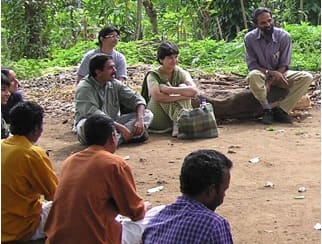
Conservation
The ICCA Consortium has adopted the definition of ‘conservation’ established by the World Conservation Strategy of 1980, namely: “…[conservation is] a positive endeavour including: maintenance of ecological process and life-support systems; preservation of genetic diversity; sustainable utilization of species and ecosystems; restoration and enhancement of the natural environment”.[1] While the practice of conserving nature is as old as people, the concept of ‘conservation’ is relatively recent, has gone through profound changes, and remains today diverse and contested. The beginning of the concept may be found in royalist and colonial attitudes, aimed at creating areas with abundant wildlife that could be easily hunted by a privileged few.[2] The nascent tourism industry brought the promotion of a ‘nature wilderness’ mystique, with national parks as its beacons, accessible only to privileged customers.[3] And, throughout the last century, conservation has been shaped by anthropocentric approaches oriented towards “efficient, scientifically informed management of natural resources”[4] and the preservation of wildlife by professionalised agencies and dedicated policies.
Today, the idea of pristine ecosystems untouched-by-humans has mostly been abandoned, but the notion and practice of ‘fortress conservation’[5] unfortunately remains relatively frequent.[6] More comprehensive attitudes can also be found in both literature and practice. In the last few decades, community- and rights-based conservation has become more popular among governmental agencies and conservation organisations – in name if not always in deeds.[7] Although translation between the concept of conservation and indigenous outlooks is not straightforward,[8] some indigenous peoples and local communities have even been willing to appropriate the concept for themselves and adapt it to their own practices. In this sense, conservation by indigenous peoples and local communities (‘indigenous conservation’[9]) is self-determined, rooted in local contexts, and has led to sustaining innumerable territories of life throughout the world. This is what many indigenous peoples and local communities have been practicing for generations, applying their adaptive knowledge and skills, and negotiating, deciding and enforcing their customary laws and collective rules about access to and use of land, water, biodiversity and other gifts of nature.
Indigenous conservation does not distinguish between conservation and community wellbeing, as setting them in opposition would undermine the social relations and cultural norms that have successfully conserved nature through time. Indigenous conservation is not technocratic nor implemented through state institutions and laws. It is conservation based on local collective capacities and rights, and the free assumption of collective responsibilities as part of cultural, spiritual and social practices.[10] Indigenous conservation and the perpetuation of relationships that sustain a community’s territories of life are central to territories of life and sustainable self-determination.
Can ICCAs-territories of life deliver conservation results on a pair with ‘fortress conservation’?
Fortress conservation approaches and conservation by indigenous peoples and local communities may lead to similar results, but their means and objectives are radically different. While fortress conservation requires the fencing-off of peoples and communities from designated territories, indigenous and community conservation acts through the maintenance of equilibrium and synergy between human and natural elements, or their re-creation when disrupted. While in fortress conservation management is delegated to professional experts and guards, in indigenous and community conservation the concerned people themselves define and implement conservation measures. There are innumerable examples of territories of life where the management practices are very similar to those that pertain to conventional protected areas. These include: securing strict protection levels that avoid any type of disrespect, disturbance or change to specific sites; securing sustainable use of resources while guaranteeing the preservation of large ecosystems; conserving specific natural features, species or habitats.[11] These examples of management practices in indigenous and community conservation are found in sacred sites, the territories of peoples in voluntary isolation, community-based wildlife sanctuaries and the many areas where customary rules regulate access and use of biodiversity. Overall, the contribution of territories of life to conservation, both within and outside protected areas, is today undisputable and broadly recognised.[12]
Key references:
Muir, 1901; IUCN, 1980; Stevens, 1997 (and Nietschmann quoted therein); Berkes, 1999; Posey, 1999; Colchester, 1994; Chatty and Colchester, 2002; Wilshusen et al., 2002; Murombedzi, 2003; Adams, 2004; Nadasdy, 2005; Feit, 2007; Sodhi and Ehrlich, 2010; Kothari, Camill and Brown et al., 2013; Gavin et al., 2015; Oldekop et al., 2015; Jonas, Makagon and Roe, 2016; Corrigan et al., 2018; Farvar et al., 2018; Garnett et al., 2018; Büscher and Fletcher, 2019.
[1] IUCN, 1980.
[2] Adams, 2004.
[3] Colchester, 2002.
[4] Sodhi and Ehrlich, 2010, page 10.
[5] Brockington, 2002.
[6] Wilshusen et al., 2002. For the current debate on resurging strict conservation actions, see Wilson (2016) and the critiques raised, among the others, by Fletcher and Büscher (2016).
[7] See, for instance, Gavin et al., 2015.
[8] Nadasdy, 2005; Feit, 2007.
[9] Farvar et al., 2018.
[10] Berkes, 1999.
[11] Borrini-Feyerabend et al., 2010. For similarities and differences between types of ICCAs and types of protected areas, see: Kothari et al., 2012.
[12] Corrigan et al., 2018 and Garnett et al. 2018, and references therein.